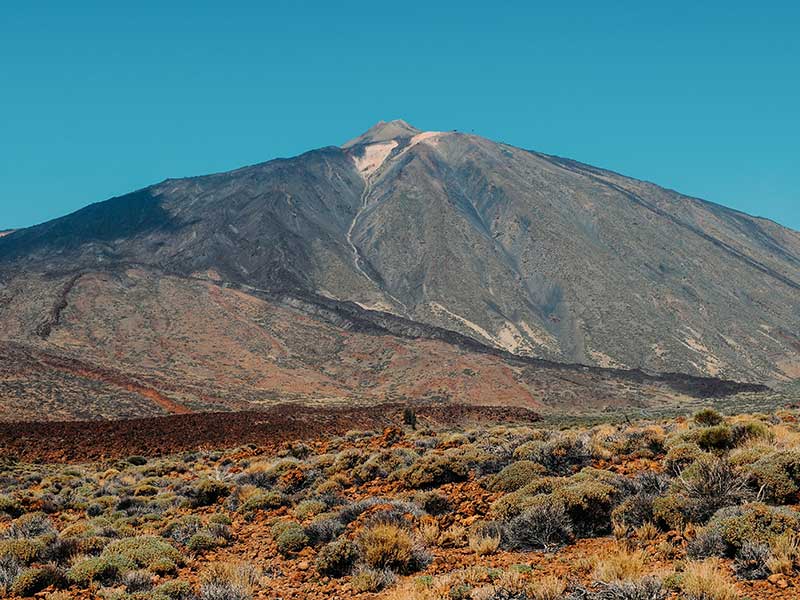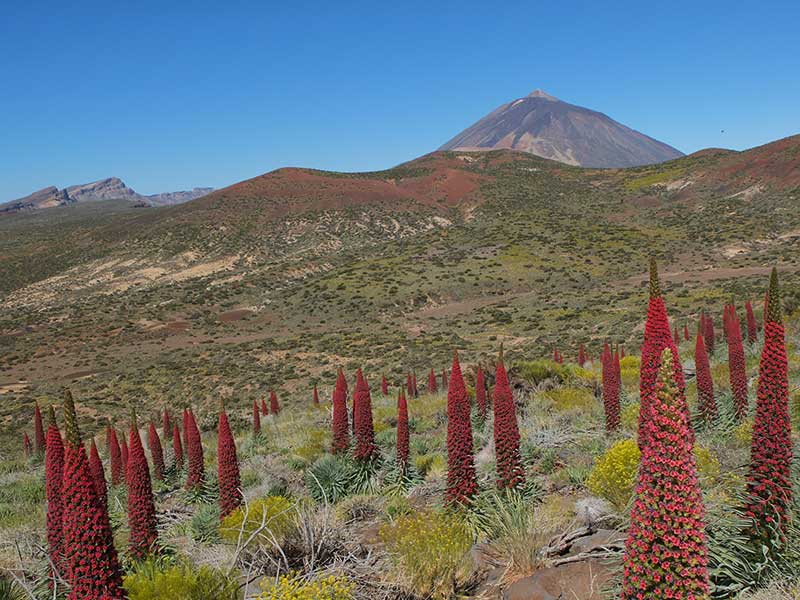Teide National Park: Cañadas, the foothills and cliffs of the caldera at the foot of the volcano.

It was declared as a park in 1954 and is exactly in the centre of the island of Tenerife and includes the Teide, one of the best known places are Las cañadas del Teide.
YOU MAY BE INTERESTED IN: Travelling to the Canary Islands".
The Teide is a volcano that is located on the island of Tenerife which, with a surface area of 2,034 square kilometres, is the largest of the seven islands that make up the Canary IslandsIt is located 300 kilometres from the Iberian Peninsula and just over 300 kilometres from the African continent.
At 3,718 metres above sea level, Mount Teide is the highest peak in Spain. Spain. In 1954 both Teide and its entire perimeter were declared Teide National Park, and in 2007 it was declared a World Heritage Site. Nowadays there is a cable car that takes you up to La Rambleta, located at 3,555 metres above sea level, in just a few minutes, and the views are breathtaking.
The Teide National Parkwith its 18,990 hectares, receives more than 3 million visitors every year, is the most visited National Park in Spain and the most visited in the world. EuropeIt is the second most visited volcano in the world. In addition, among the ten most impressive European volcanoes, Teide was selected to occupy the second place (after Etna), a privilege.
READ ALSO: The beauty of the National Parks, discover them in these 15 images "
El Teide and Las Cañadas del Teide

Las Cañadas del Teide. The island of Tenerife is formed by the Teide volcano, and at an altitude of 2000 metres is where the Teide National Park begins. One of the main attractions of the park is its scenic charm.
It is an inhospitable place with little fauna and vegetation, but with impressive landscapes that make it an extraordinary place, with a variety of rocks that we can observe.
Landscapes of Las cañadas del Teide.
Between the foothills and the cliffs of the caldera are the Cañadas del Teide. These are the plains at the foot of the volcano.
At the mouth of the Teide volcano you can see the traces of the last eruptions in the form of black tongues of solidified lava. A striking aspect of the Teide National Park is the variety of colours, ochre and grey, that paint the landscape.
Fauna and flora of Las Cañadas del Teide
More than 400 species are catalogued in Las Cañadas del Teide, it is complicated to observe the animals in the park. Some of the animals that can be observed in the park are: The Black-headed Lizard, a reptile unique in the western Canarais. As well as the Woodchat Shrikes, the Common Kestrel, and the Teide Finch. The mammals that can be found here were introduced into the environment by man during his colonisation of the island, with the exception of the Morunian Hedgehog. At present there is a serious problem with the species introduced by man, such as rabbits and rats, which have no natural predators and their population is growing uncontrollably, posing a serious threat to the native flora.
In Las Vaguadas we can find more flora, where there are many plants endemic to the area, such as the Taginaste Rojo, while on the slopes of the volcano only the Teide Violets grow, which grow in a very extreme and arid environment.
Tourism in Teide National Park
Most of the visits to the Teide are made by tourists who spend only a few hours on guided tours, the vast majority use the cable car to climb to the summit. The cable car is situated at an altitude of 2,356 metres and in a matter of 8 minutes it climbs to 3,555 metres. From the cable car you can take a short hike to the summit.
If we like hiking we can make some unforgettable excursions through Las Cañadas del Teide, there are some that make a circumvallation of the peak and recreate various ravines.
There is another great excursion which consists of an ascent to the peak. This excursion is reserved for experts as it is a complicated and very hard ascent.
There are many more excursions for hiking lovers, among them the visit to the Rocas de García, Los Huevos del Teide, Bombas volcanicas, etc.
The Teide National Park has published maps and publications to provide complete information about the park. One very important rule is that it is strictly forbidden to leave the marked trails, as any footprints outside the trail would remain marked on the ground for decades due to the characteristics of its volcanic soil. It is therefore essential to comply with this rule in order to conserve this beautiful environment.
If you have been left wanting more, we leave you a video of a special ascent to Teide, by Hidden DonoSStia:
Don't miss any adventure in the Pyrenees!
